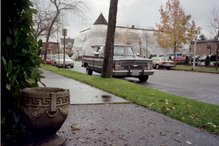
Green lawn at the back windows rose as a steep curtain and the library alley at the top was beyond sight. In the 1966 library quiet, with no security cameras, the whole neighborhood was unseen alone there in a quiet intimacy. The windowlight shone on 900s, politics and history, and biographies.

Along the the building wall that lawn privacy did not impress intimacy onto the break room, its scrubbed neutrality framed a daybed reserved for anyone who might become ill while in the library; the room was like the room of the school nurse. But in that room, someone said something unusual, once.
I started to work at the library in July 1965, I
worked all day every Saturday.Usually I walked to my parents house on the
lunch hour, and mid-morning, mid-afternoon, I had fifteen minute breaks. There was a Christmas Tree set up at the desk
of the Librarian, the high school pages decorated this together.
2016 marks the 50th anniversary of the
Mrs. Pollifax series, by Dorothy Gilman.
As a new reader, at page eight of the Unexpected Mrs. Pollifax, I came
across a recollection of Mrs. Pollifax – her cousin had brought her with him
when he shot rats at the county dump.
The McCormick Library break room returns steadily to my thoughts. I believe someone said, in the break room, on
the weekend they shot rats at the Purdy Dump.
New York Times, March 20, 1966 – the internet
reports a review by Harold C. Schonberg of this first Mrs. Pollifax mystery
novel, and the review refers to the rats at the dump passage, which is on page
eight.
When I was a fifth or sixth grader, as a guest of
our neighbors, who had moved, we walked along one road where a telephone wire
filled up with crows. My neighbor said
to me “There is a bounty on crows. You
shoot a crow and bring it in and they give you money for killing it.”
It sounded horrible to me and I accepted that,
doubtless, that was true. The Pacific
Northwest Room could not find much about a bounty on crows, or about a bounty
on rats in 1966.
One of the other high school pages, in probably
1966, said that on the weekend, they shot rats.
I can wonder, now, if their imagination brought them from Mrs. Polifax
to a comment like that.
The idea entered a poem I composed in 1969. The idea had seemed horrible to me, my poem
was about the deaths of animals.
IF TOM SHOOTS RATS AT THE PURDY DUMP
Tom will die in the accident.
Tom shot rats at the Purdy Dump.
Tom died in the accident.
Snow drifts in the soft folds of the workman's
jeans.
She can see him step around her with a shotgun.
We know why people shoot at cranes.
Shooting anything is cutting
your own skin.
There is a cloud of blood along
the surface of the snow.
She whispers
I am dying
She is certain she is dying.
But obviously nothing has changed.
She holds her arms up, staring at
her undependable dark veins.
This is the day of the rising souls
All Souls' Day
when the dead rise in the earth.
Cranes and the animals die around her.
They cover up the ground.
They cover up the broken grass.
Her arms fall across the wings of a swan.
She has died.
The wings and arms are crossed.
The feathers rustle in the rising wind.
They will never lift off the earth.
They end like a falling tree.
They are already lost.
It was only with Tacoma Reads Together and the
choice of Dashielle Hammett's Maltese Falcon that I began to read some mystery
novels. The difficulty of reading about
violence is a part of almost all the novels they call mysteries – many of the
mystery novels have Socially Redeeming Qualities such as the establishment of a
learning opportunity for the reader who needs to grasp the events and the
societal situations and misfortunes that involve crime and violence.



No comments:
Post a Comment